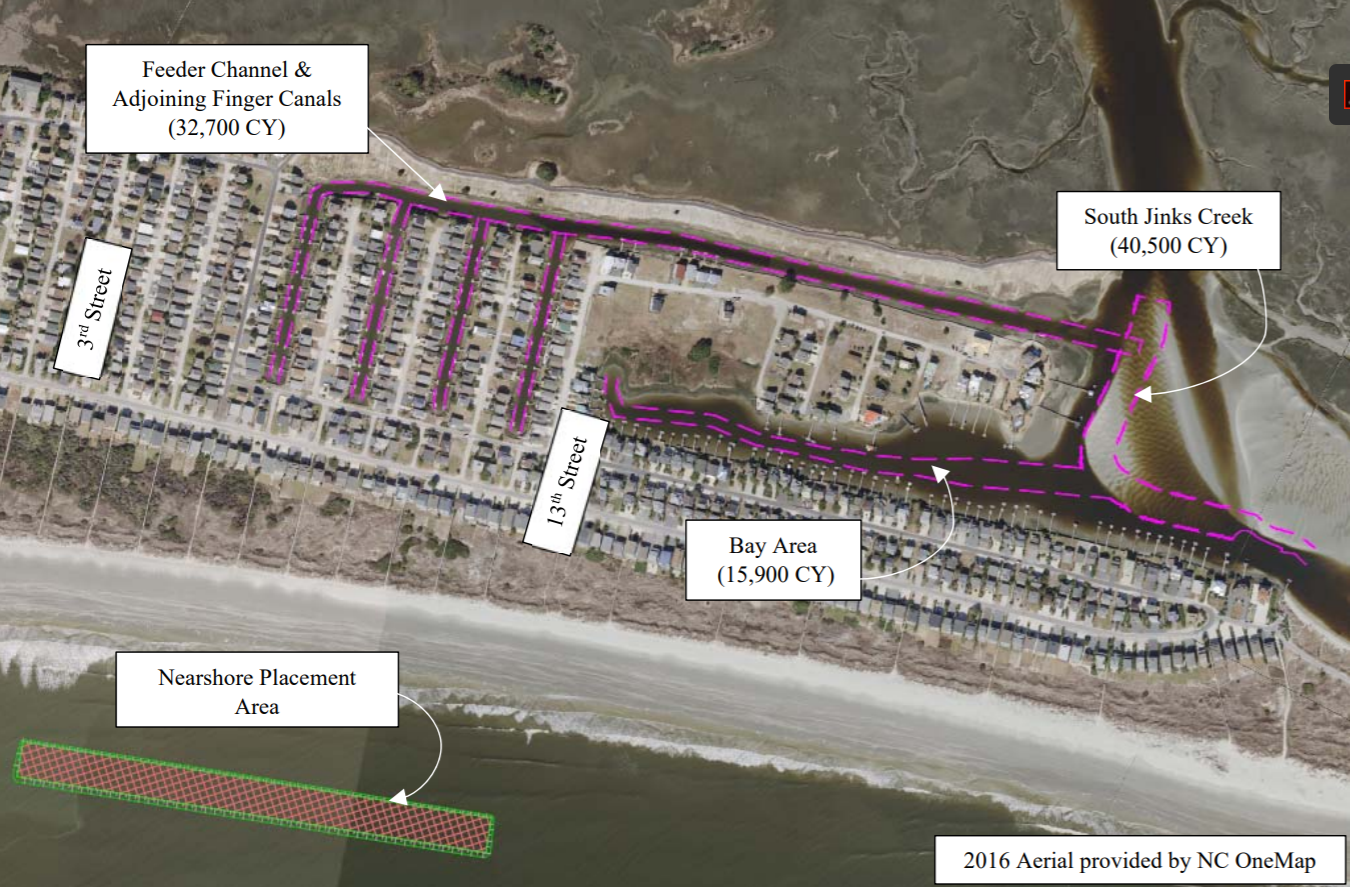
Sunset Beach has resubmitted permit applications to state and federal agencies after finding a new proposed location to put the sand the town hopes to have pumped from surrounding waterways.
The town earlier this week turned in modified dredge permit applications to the N.C. Division of Coastal Management and U.S. Army Corps of Engineers, asking to place beach-compatible sand just offshore.
Supporter Spotlight
This newest proposal to put beach quality sand pumped from south Jinks Creek onto a nearshore site comes after beachfront property owners said they would refuse to grant the town property easements.
According to information provided on the town’s website, those property owners expressed concerns about the possibility of losing “beach front” ownership. The landowners pointed to a North Carolina statute that reads, in part, “the title or land in or immediately along the Atlantic Ocean raised above the mean high-water mark by publicly financed projects which involve hydraulic dredging or other deposition of spoil materials or sand vests in the State.”
The proposed project would be partially funded through state grants.
Under the original proposal, the town would need to obtain temporary construction easements to put equipment on private properties to move sand dredged from the creek onto a stretch of oceanfront between Fifth and 12th streets.
Shortly before the town asked the Corps to pull its permit application early this year, the federal agency sent the town a letter noting that the proposed original sand placement site is not eroding or in need of additional sand.
Supporter Spotlight
The town also considered moving beach-compatible sand to an adjacent beach in a neighboring town, but state rules mandate that the sand has to be maintained and, if temporarily removed, returned to the littoral zone from where it was dredged.
Temporarily storing the sand in an upland facility would take more time to get the sand on the beach and would significantly raise the project’s cost, officials say.
The option of nearshore placement was evaluated as “a last resort,” according to the town’s website. “Although nearshore placement is not a widely used option for non-federal stakeholders, the alternative provides a beneficial reuse option for placement of the beach material from south Jinks Creek. Nearshore placement also provides an environmentally acceptable and least cost alternative that meets the purpose and need of the project.”
The modified permit application proposes to move an estimated 40,500 cubic yards of beach-compatible sand from south Jinks Creek in the nearshore along about 2,000-foot stretch of shoreline seaward between Third and 13th streets.
The town chose this particular spot after evaluating impacts from recent hurricanes, according to information provided on Sunset Beach’s website.
“The Town experienced noticeable erosion impacts in the beach and dune system along their central shoreline region extending between 3rd Street and 13th. Although the Town did not document the beach and shoreline impacts, data obtained from the DCM (Division of Coastal Management) corroborates the general consensus of erosion concerns in the area of 3rd through 13th streets,” according to Moffatt & Nichol, the Raleigh-based engineering firm hired by the town to oversee the proposed dredging project.
Sunset Beach resident Richard Hilderman, a vocal opponent of the proposed project, has argued that erosion data along that section of beach needs to be further examined and that the town has not justified placing the sand offshore.
“In order to verify the claim that the beach between 3rd and 13th St is eroding the actual data needs to be evaluated,” he said in an email. “They have identified areas where the spoils could be stored until a beneficial site can be found in the Tubbs Inlet littoral zone. This sand is too valuable to be lost by placing it offshore where (it) will be removed by the long-shore transport system.”
Hilderman is submitting comments to the state and the Corps, which have both opened 30-day public comment periods on the permit applications.
The town received a Coastal Area Management Act, or CAMA, major permit a year ago to dredge roughly 3 miles of waterway and place beach-compatible sand on a little more than 8 acres of oceanfront.
That permit authorized the project with the condition that the maximum dredging depth be 2 feet below mean low water, which is consistent with a state ruling prohibiting canals and boat basins from being dredged deeper than connecting waters.
In February, the Coastal Resources Commission, or CRC, granted a variance to that permit that allows the town to dredge about 18 acres, including south Jinks Creek, to a depth deeper than the connecting waters along its eastern border.
The variance allows dredging about 10,650 feet of south Jinks Creek, the bay area and the feeder channel, to a depth of no more than 6 feet below mean water. A series of finger canals would be dredged to 5 feet below mean low water.
Sunset Beach officials began looking into maintenance dredging of the waterways, including Mary’s Creek and Turtle Creek, about a decade ago to improve and restore navigation access.
Town officials say dredging will help the town manage future development because it will create a pier head alignment that will allow the town to monitor future dock construction to ensure new piers will not impede navigation.
An estimated 48,600 cubic yards of dredged sand deemed noncompatible to be placed on the beachfront will be placed in an upland landfill.
The town will have to get a major modification to its existing CAMA permit from the state. DCM is accepting public comments through Oct. 26.
The Corps had not published its comment period for the permit application as of deadline for this report Friday.







